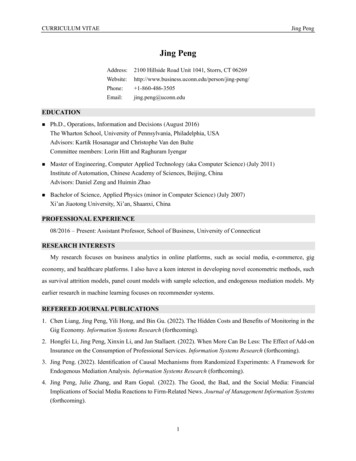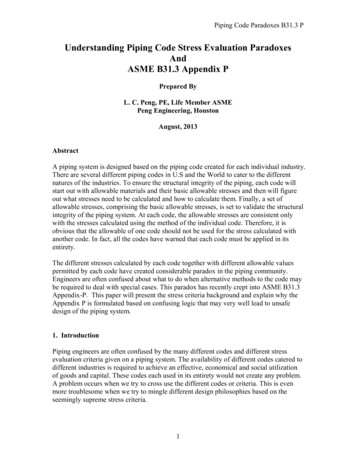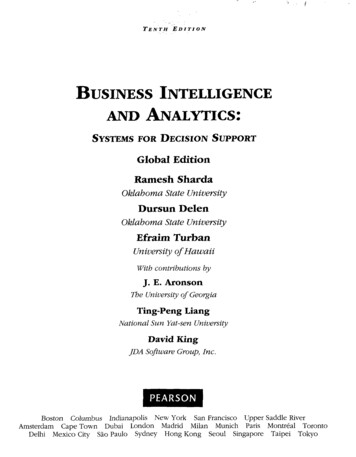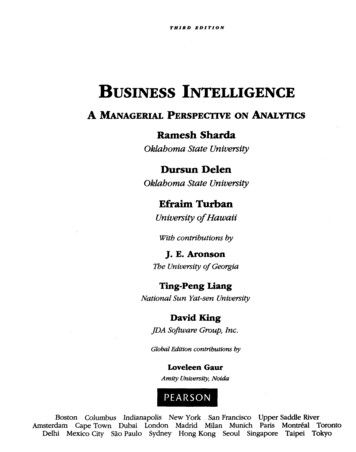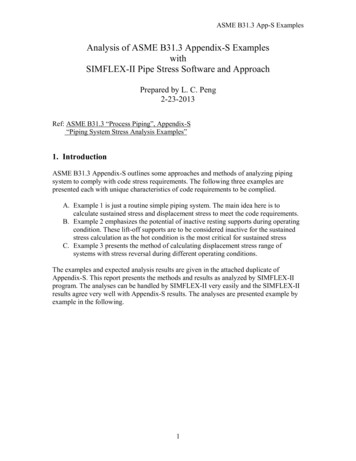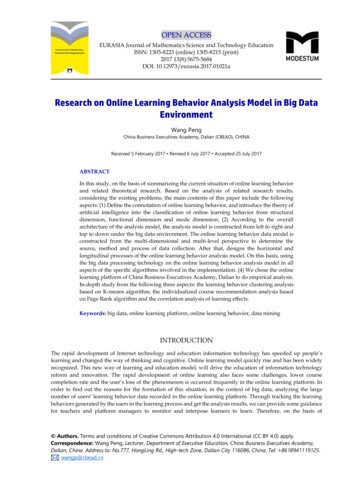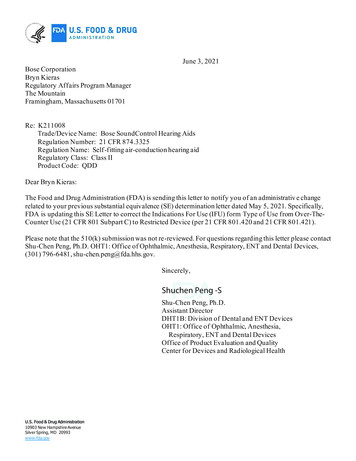
Transcription
June 3, 2021Bose CorporationBryn KierasRegulatory Affairs Program ManagerThe MountainFramingham, Massachusetts 01701Re: K211008Trade/Device Name: Bose SoundControl Hearing AidsRegulation Number: 21 CFR 874.3325Regulation Name: Self-fitting air-conduction hearing aidRegulatory Class: Class IIProduct Code: QDDDear Bryn Kieras:The Food and Drug Administration (FDA) is sending this letter to notify you of an administrativ e changerelated to your previous substantial equivalence (SE) determination letter dated May 5, 2021. Specifically,FDA is updating this SE Letter to correct the Indications For Use (IFU) form Type of Use from Over-TheCounter Use (21 CFR 801 Subpart C) to Restricted Device (per 21 CFR 801.420 and 21 CFR 801.421).Please note that the 510(k) submission was not re-reviewed. For questions regarding this letter please contactShu-Chen Peng, Ph.D. OHT1: Office of Ophthalmic, Anesthesia, Respiratory, ENT and Dental Devices,(301) 796-6481, shu-chen.peng@fda.hhs.gov.Sincerely,Shuchen Peng -SShu-Chen Peng, Ph.D.Assistant DirectorDHT1B: Division of Dental and ENT DevicesOHT1: Office of Ophthalmic, Anesthesia,Respiratory, ENT and Dental DevicesOffice of Product Evaluation and QualityCenter for Devices and Radiological HealthU.S. Food & Drug Administration10903 New Hampshire AvenueSilver Spring, MD 20993www.fda.govD o c I D # 0 4 0 1 7 .04 .2 4
May 5, 2021Bose CorporationBryn KierasRegulatory Affairs Program ManagerThe MountainFramingham, Massachusetts 01701Re: K211008Trade/Device Name: Bose SoundControl Hearing AidsRegulation Number: 21 CFR 874.3325Regulation Name: Self-Fitting Air-Conduction Hearing AidRegulatory Class: Class IIProduct Code: QDDDated: April 1, 2021Received: April 5, 2021Dear Bryn Kieras:We have reviewed your Section 510(k) premarket notification of intent to market the device referencedabove and have determined the device is substantially equivalent (for the indications for use stated in theenclosure) to legally marketed predicate devices marketed in interstate commerce prior to May 28, 1976, theenactment date of the Medical Device Amendments, or to devices that have been reclassified in accordancewith the provisions of the Federal Food, Drug, and Cosmetic Act (Act) that do not require approval of apremarket approval application (PMA). You may, therefore, market the device, subject to the generalcontrols provisions of the Act. Although this letter refers to your product as a device, please be aware thatsome cleared products may instead be combination products. The 510(k) Premarket Notification Databaselocated at /cfpmn/pmn.cfm identifies combinationproduct submissions. The general controls provisions of the Act include requirements for annual registration,listing of devices, good manufacturing practice, labeling, and prohibitions against misbranding andadulteration. Please note: CDRH does not evaluate information related to contract liability warranties. Weremind you, however, that device labeling must be truthful and not misleading.If your device is classified (see above) into either class II (Special Controls) or class III (PMA), it may besubject to additional controls. Existing major regulations affecting your device can be found in the Code ofFederal Regulations, Title 21, Parts 800 to 898. In addition, FDA may publish further announcementsconcerning your device in the Federal Register.Please be advised that FDA's issuance of a substantial equivalence determination does not mean that FDAhas made a determination that your device complies with other requirements of the Act or any Federalstatutes and regulations administered by other Federal agencies. You must comply with all the Act'srequirements, including, but not limited to: registration and listing (21 CFR Part 807); labeling (21 CFR PartU.S. Food & Drug Administration10903 New Hampshire AvenueSilver Spring, MD 20993www.fda.govDoc ID# 04017.04.24
K211008 - Bryn KierasPage 2801); medical device reporting (reporting of medical device-related adverse events) (21 CFR 803) fordevices or postmarketing safety reporting (21 CFR 4, Subpart B) for combination products portingcombination-products); good manufacturing practice requirements as set forth in the quality systems (QS)regulation (21 CFR Part 820) for devices or current good manufacturing practices (21 CFR 4, Subpart A) forcombination products; and, if applicable, the electronic product radiation control provisions (Sections 531542 of the Act); 21 CFR 1000-1050.Also, please note the regulation entitled, "Misbranding by reference to premarket notification" (21 CFR Part807.97). For questions regarding the reporting of adverse events under the MDR regulation (21 CFR Part803), please go to ical-device-problems.For comprehensive regulatory information about medical devices and radiation-emitting products, includinginformation about labeling regulations, please see Device Advice comprehensive-regulatory-assistance) and CDRH education/cdrh-learn). Additionally, you may contact theDivision of Industry and Consumer Education (DICE) to ask a question about a specific regulatory topic. Seethe DICE website ision-industry-and-consumer-education-dice) for more information or contact DICEby email (DICE@fda.hhs.gov) or phone (1-800-638-2041 or 301-796-7100).Sincerely,Shuchen Peng -SShu-Chen Peng, Ph.D.Assistant DirectorDHT1B: Division of Dental and ENT DevicesOHT1: Office of Ophthalmic, Anesthesia,Respiratory, ENT and Dental DevicesOffice of Product Evaluation and QualityCenter for Devices and Radiological HealthEnclosure
DEPARTMENT OF HEALTH AND HUMAN SERVICESFood and Drug AdministrationForm Approved: OMB No. 0910-0120Expiration Date: 06/30/2023Indications for UseSee PRA Statement below.510(k) Number (if known)K211008Device NameBose SoundControl Hearing AidIndications for Use (Describe)The Bose SoundControl Hearing Aids is intended to amplify sound for individuals 18 years of age or older withperceived mild to moderate hearing impairment. It is adjusted by the user to meet the user’s hearing needs. No preprogramming or hearing test is necessary. The device is intended for direct-to-consumer sale and use without theassistance of a hearing care professional.Restricted Device (per 21 CFR 801.420 and 21 CFR 801.421).Type of Use (Select one or both, as applicable)Prescription Use (Part 21 CFR 801 Subpart D)Over-The-Counter Use (21 CFR 801 Subpart C)CONTINUE ON A SEPARATE PAGE IF NEEDED.This section applies only to requirements of the Paperwork Reduction Act of 1995.*DO NOT SEND YOUR COMPLETED FORM TO THE PRA STAFF EMAIL ADDRESS BELOW.*The burden time for this collection of information is estimated to average 79 hours per response, including thetime to review instructions, search existing data sources, gather and maintain the data needed and completeand review the collection of information. Send comments regarding this burden estimate or any other aspectof this information collection, including suggestions for reducing this burden, to:Department of Health and Human ServicesFood and Drug AdministrationOffice of Chief Information OfficerPaperwork Reduction Act (PRA) StaffPRAStaff@fda.hhs.gov“An agency may not conduct or sponsor, and a person is not required to respond to, a collection ofinformation unless it displays a currently valid OMB number.”FORM FDA 3881 (6/20)Page 1 of 1PSC Publishing Services (301) 443-6740EF
Bose SoundControlSpecial 510(k)April 1st, 2021510(k) SUMMARY - K211008Applicant: Bose CorporationAddressThe Mountain RdFramingham, MA 01701Contact: Bryn KierasPhone: (978) 457-2972Fax: N/AEstablishment Registration Number: 3003361262Trade Name: Bose SoundControl Hearing AidsCommon/Usual Name: Self-Fit Wireless Air-Conduction Hearing AidClassification Name: Self-Fit Wireless Air-Conduction Hearing AidRegulation Number: 874.3325Product Code: QDDClassification: Class IIPanel: Ear, Nose, and Throat DevicesPredicate Device: Bose Hearing Aid (DEN180026)Submitter/510(k) Holder: Bose CorporationSubmission Date: April 1, 2021Device Description:Per 21 CFR 874.3325 a self-fitting wireless air conduction hearing aid is a wearable soundamplifying device that is intended to compensate for impaired hearing and incorporatestechnology, including software, that allows users to program their hearing aids. Thistechnology integrates user input with a self-fitting strategy and enables users toindependently derive and customize their hearing aid fitting and settings. Self-fittingwireless air conduction hearing aids are class II medical devices.The Bose SoundControl Hearing Aids (Model BMD0012) are self-fitting wireless airconduction hearing aids consisting of the Novidan Inc. hardware, Bose software, the BoseHear app, and accessories supplied in the carton.Bose SoundControl Hearing Aids
Bose SoundControlSpecial 510(k)April 1st, 2021Each hearing aid in the pair functions and interacts with the Bose Hear app independentlyand as a system. The hearing aids are powered by a disposable size 312 zinc-air battery.The hearing aids incorporate microphones for audio input and sound is delivered to the earvia a receiver that can be coupled with open or closed domes. The hearing aids arecontrolled via on-board button controls and wirelessly via the Bose Hear app (iOS andAndroid). The controls allow the user to configure parameters, settings, and listeningmodes.Intended Use:Bose SoundControl Hearing Aids are a pair of user-fitted wireless air conduction hearingaids intended for use by individuals 18 years and older with perceived mild to moderatehearing impairment.Indications for Use:The Bose SoundControl Hearing Aids are intended to amplify sound for individuals 18years of age or older with perceived mild to moderate hearing impairment. It is adjustedby the user to meet the user’s hearing needs. No pre-programming or hearing test isnecessary. The device is intended for direct-to-consumer sale and use without theassistance of a hearing care professional.Self-Selection Labeling:Self-Selection Labeling had been included in the Bose SoundControl Hearing Aids IFU tomitigate the risk of improper self-selection. Summarized, it addresses:xxxxxIdentifying situations in which Bose SoundControl Hearing Aids may help you hearbetter.Identifying situations in which Bose SoundControl Hearing Aids may not be right for theuser.Identifying criteria that indicate the user should see a hearing professional.Informing the user that the Bose SoundControl Hearing Aids will not restore normalhearingInforming the user that it is good health practice to have hearing loss evaluated by anappropriate healthcare professional.Special Controls:The Bose SoundControl Hearing aid conforms to the special controls stated in 21 CFR874.3325. Bose satisfied these requirements through:xClinical DataBose SoundControl Hearing Aids
Bose SoundControlxxxSpecial 510(k)April 1st, 2021Non-Clinical Performance TestingHuman Factors ValidationLabelingComparison of Technological Characteristics:Both the subject (Bose SoundControl Hearing Aids) and the predicate (Bose Hearing Aid)are self-fit direct-to-consumer hearing aids indicated for individuals 18 and older withperceived mild to moderate hearing impairment. The same fundamental technology ispresent in both hearing aids to allow the user to control and customize the device to theuser’s hearing needs.Both devices contain the same technological characteristics:xxxxxxSelf-Fit Hearing AidHome Healthcare Environment useBluetoothOn Device ControlsApp (Bose Hear app)Software Platform Compatibility (iOS, Android)Technological differences of the Bose SoundControl Hearing Aids were as follows:x An updated Form Factor to a traditional RIC style hearing aidx A Replaceable Batteryx Removal of Telephony and Streamingx Removal of Active Noise Reduction (ANR)The Bose SoundControl Hearing Aids were evaluated through Clinical and Non-ClinicalPerformance Testing to demonstrate the substantial equivalence to the predicate device asdescribed in DEN180026.Clinical Data:The results of the clinical study used in DEN180026 provide conclusive evidence that theBose Self-Fitting method results in outcomes not in any way inferior to professional fittingfor adults with mild to moderate hearing loss. Based on patient satisfaction and preferencereports, subjects in the Self-Fit Group were satisfied with and preferred their own selfadjusted settings to the professionally-selected settings.A clinical validation study demonstrated that Bose SoundControl Hearing Aids deliveradequate amplification to compensate for mild to moderate hearing loss (Figure 1).Bose SoundControl Hearing Aids
Bose SoundControlSpecial 510(k)April 1st, 2021Figure 1: Mean (open black symbols) 1 standard deviation (error bars) of the real-ear aided response (REAR) measured whenmatching to NAL-NL2 amplification targets (filled blue symbols) for average conversational speech. REAR was obtained in 34ears, with open and closed eartips, for three standard audiometric configurations (N2, N3 and S2; Bisgaard et al, 2010)representing mild to moderate hearing loss.Because the self-fitting method in the Bose SoundControl is the same as the one used inthe DEN180026 device the prior DEN180026 clinical data can be used to show that theBose SoundControl also results in outcomes not in any way inferior to professional fittingfor adults with mild to moderate hearing loss.Non-clinical Performance Testing:Bose conducted performance testing on the Bose SoundControl Hearing Aids to provide areasonable assurance of safety and effectiveness of the device as compared to the BoseHearing Aid (DEN180026). The results are summarized in the table below:Test Standard/ MethodIEC 60601- 1:2005 A1:2012IEC 60601-2-66:2019IEC 60601-1-11:2015*IEC 60601-1-2:2014ANSI/ASA S3.22 2014Bose-specified procedure, ‘Medical –Usability Engineering Procedure’specifies how to apply human factorsengineering methods to productdevelopmentIEC 60601-1-6: 2010 A1:2013Test Purpose/DescriptionElectrical SafetyResultElectromagneticCompatibility (EMC)ElectroacousticUsability EngineeringPassPassPassPassBose SoundControl Hearing Aids
Bose SoundControlTest Standard/ Method10993-1:2009/TC 1 2010 AssessmentISO 10993-5 CytotoxicityISO 10993-10 Irritation / SensitizationIEC 62304:2006 A1:2015*Applicable sectionsSpecial 510(k)April 1st, 2021Test assPassThe range of testing and all acceptance criteria are appropriate to evaluate this devicebased on its proposed intended use. All acceptance criteria were met.ANSI/ASA S3.22 2014 MeasurementsIn order to prove substantial equivalence with the predicate device, Bose evaluated theANSI S3.22 data set from the predicate (DEN180026) devices ANSI/ASA S3.22measurements in order to establish substantial equivalence in acoustic performance.TestOSPL90 curveMax OSPL90HFA OSPL90Bose HearingAid(DEN180026)Figure 2 (left)115 dBSPL112 dBSPLBoseSoundControlHearing AidsFigure 3 (left)113 dBSPL106 dBSPLDiscussionHFA FOG43 dB30 dBRTG36 dB29 nEINBattery currentFigure 2 (right)Figure 3 (right) 200 - 8000 Hz 200-8000 HzSame3.6% 1%Same26 dBSPLN/A 27 dBSPL2.8 mASamePredicate device wasrechargeableSameAdequate for fitting moderatehearing loss (55 dBHL) asprescribed by NAL-NL2Adequate for fitting moderatehearing loss (55 dBHL) asprescribed by NAL-NL2Adequate for fitting moderatehearing loss (55 dBHL) asprescribed by NAL-NL2Bose SoundControl Hearing Aids
Bose SoundControlSpecial 510(k)April 1st, 2021Figure 2: OSPL90 (left panel) and frequency response (right panel, solid line) curves for Bose Hearing Aid as measured in 2cccoupler. Note that these curves represent a single measurement of one unit.Figure 3: Nominal OSPL90 (left panel) and frequency response (right panel) curves for Bose SoundControl Hearing Aids asmeasured in 2cc coupler.Based on the above information, Bose concludes that the Bose SoundControl Hearing Aidsare substantially equivalent to the predicate device Bose Hearing Aid (DEN180026).Usability TestingBose conducted a human factors validation test (i.e., summative usability test) of the BoseSoundControl Hearing Aids in accordance with FDA’s final guidance, Applying HumanFactors and Usability Engineering to Medical Devices, Guidance for Industry and Foodand Drug Administration Staff (2016). The human factors validation test included 20untrained participants representing the intended user population (individuals 18 year of ageor older with perceived mild to moderate hearing impairment), each of whom performedhands-on use scenarios and knowledge tasks with the Bose SoundControl Hearing Aids,including the Bose Hear app, accessories, and user documentation. After the use scenariosand knowledge tasks, the moderator asked open-ended questions to collect participants’subjective assessments of use safety and usability. The test found that the BoseSoundControl Hearing Aids are safe and effective for the intended users, uses, and useenvironments.Bose SoundControl Hearing Aids
Bose SoundControlSpecial 510(k)April 1st, 2021Substantial Equivalence:The Bose SoundControl Hearing Aids has the same intended use and fundamentaltechnology as the predicate, the Bose Hearing Aid (DEN180026). In the same manner asits predicate the Bose SoundControl Hearing Aids are a user-fitted wireless air-conductionhearing aid intended for over-the-counter use by individuals 18 years or older withperceived mild to moderate hearing impairment. The change discussed in the submission isabout the Bose SoundControl Hearing Aids new form factor. The wearable portion of thedevice is a familiar RIC design powered by disposable size 312 zinc-air battery. Clinicaldata proves that the Bose SoundControls Hearing Aids are substantially equivalent to itspredicate device in acoustic performance. Non-clinical performance testing has beenderived from and conducted to ensure that device form factor change does not impact thebasic threshold for safety and effectiveness as established by the predicate DEN180026.Device firmware is derived from the DEN180026 device with minor modifications relatedto the electronics and smaller footprint. Software is derived from the DEN180026 withminor modifications to the user interface for aesthetic reasons. There has been no changefrom the Self-Fit technology demonstrated in the predicate device submission. Designverification results demonstrate that the subject device (inclusive of softwaremodifications) has substantially equivalent performance to the predicate.Conclusion:The Bose SoundControl Hearing Aids are substantially equivalent in intended use andfundamental scientific technology to the Bose Hearing Aid (DEN180026). The BoseSoundControl Hearing Aids are considered as safe and effective as the predicate device forits intended use when used in accordance with its Instructions for Use.Bose SoundControl Hearing Aids
Counter Use (21 CFR 801 Subpart C) to Restricted Device (per 21 CFR 801.420 and 21 CFR 801.421). Please note that the 510(k) submission was not re-reviewed. For questions regarding this letter please contact Shu-Chen Peng, Ph.D. OHT1: Office of Ophthalmic, Anesthesia, Respiratory, ENT and Dental Devices, (301) 796-6481, shu-chen.peng@fda.hhs.gov.
